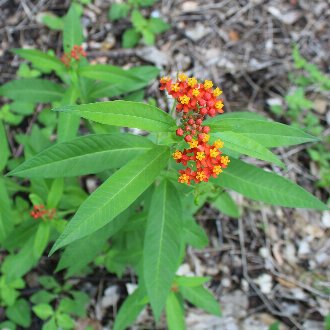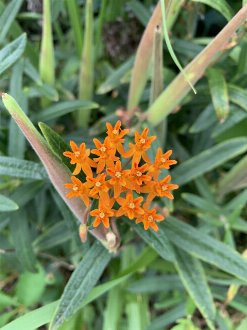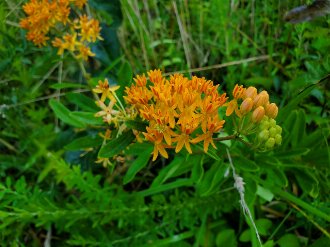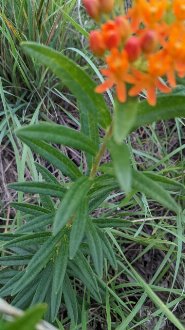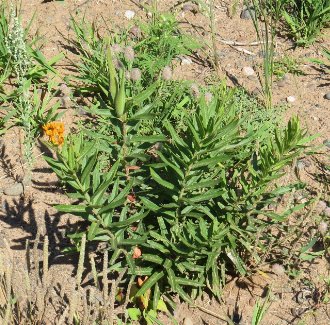Butterfly Milkweed (Asclepias tuberosa L.)
Also known as butterfly weed.
↑Summary
An orange-flowering perennial of dry, sunny areas, favoring sites with acidic soils, especially on sandy or rocky soils.
↑Range - Expand
| Legend | Color |
| Native | |
| Extirpated | |
| Native or Not Present | |
| Introduced or Not Present |
This tentative map is based on our own research. It may have limited data on Canada and/or Mexico, and there is some subjectivity in our assignment of plants as introduced vs. expanded. Read more in this blog post.
Although this plant occurs somewhere in each of these regions, it may only occur in a small part of some or all of them.
↑Similar Plants
↑Habitat
Found in dry, open habitats, especially in sandy or rocky soil. Habitats include dry, sandy fields, roadsides and railway margins, open woodlands, especially pine barrens, shale barrens, prairies, and savannahs. Although it is usually found in acidic soils, especially in the east, it has some tolerance of soil alkalinity and can be found in more calcareous soils in the arid southwest. In the southwest, it is also found in upland woodlands, riparian areas, and semideserts.
Found in both disturbed and natural habitats; natural areas where this species is found usually experience periodic fires.
Although humans have reduced the habitat for this species through fire suppression, this species has also adapted to dry areas along roadsides, railroads, and power line rights-of-way. The low surface area to root ratio and waxy coating on its leaves make it more resistant to herbicide drift than numerous other species.
↑Life Cycle
This species is a perennial.
Seeds germinate on the soil surface; seedlings are slow to develop above ground, but quickly develop a tuberous taproot and extensive root system, contributing to this species adaptation to drought and fire. On favorable sites, plants may flower in the first or second years, but more commonly, the dry, nutrient poor conditions lead this plant to take longer to develop, often not flowering until the third year. Shaded plants are also slower to develop.
Flowering habits in this species can vary widely based on conditions. Flowers most commonly develop in late spring to mid-summer, and are followed by seeds, which mature in a few months. Depending on conditions, plants may continue to flower or flower a second, separate time later in summer or early fall. Some seeds may mature and even be distributed while the plant is still flowering. In other years, plants may flower only during a single, well-defined period. Seedpods open when fully dried out, releasing the seeds to the wind, where they can be carried long distances by their wispy appendages.
A small portion of seeds germinate immediately, but most exhibit cold dormancy and germinate in the spring.
Plants are typically unaffected by low-intensity fire during the dormant season, and tend to benefit from its removal of competing vegetation. The compact, moisture-containing foliage of the growing season is somewhat resistant to fire, and plants top-killed by fire can resprout from the root system.
↑Uses
Widely planted in gardens, where it is valued for its attractive and distinctive bright orange flowers. Although difficult to transplant due to having a fragile taproot, it is easy to grow once established, provided the soils are well-drained and it does not have too much competition from other plants. It is also easy to grow from seed.
Historically, this plant was used by native Americans as a fiber plant, used to produce rope and string, as well as yarn and fabric.
↑Links & External Resources
• Asclepias tuberosa (Butterfly Milkweed) | Illinois Wildflowers (About This Site)
• Asclepias tuberosa (Butterfly Milkweed) | USDA PLANTS Database (About This Site)
• Asclepias tuberosa | Go Botany (About This Site)
• Asclepias tuberosa (Butterfly Weed) | Missouri Botanical Garden Plant Finder (About This Site)
• Asclepias tuberosa | Biota of North America Project (BONAP) (About This Site)
• Asclepias tuberosa | NatureServe Explorer (About This Site)
• Asclepias tuberosa | Missouri Plants (About This Site)
• Butterfly Weed | Maryland Biodiversity Project (About This Site)
• Asclepias tuberosa (Butterfly-weed) | Minnesota Wildflowers (About This Site)
• Asclepias tuberosa L. var. rolfsii (Britt. ex Vail) Shinners (Sandhills Butterfly-weed) | Digital Atlas of the Virginia Flora (About This Site)
• Asclepias tuberosa L. var. tuberosa (Butterfly-weed, Common Butterfly-weed) | Digital Atlas of the Virginia Flora (About This Site)




